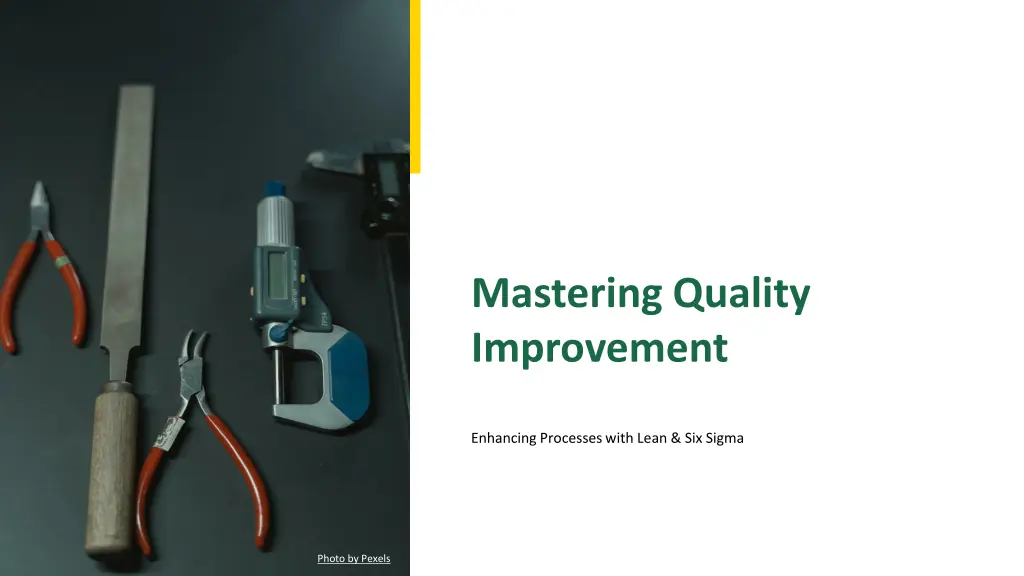
Enhancing Processes with Lean & Six Sigma Methodologies
Discover how Lean methodology focuses on eliminating waste to streamline processes and optimize resource usage, while Six Sigma aims to reduce defects and enhance quality through data-driven techniques. Learn how integrating Lean and Six Sigma can lead to efficient and effective process improvements across various industries.
Download Presentation

Please find below an Image/Link to download the presentation.
The content on the website is provided AS IS for your information and personal use only. It may not be sold, licensed, or shared on other websites without obtaining consent from the author. If you encounter any issues during the download, it is possible that the publisher has removed the file from their server.
You are allowed to download the files provided on this website for personal or commercial use, subject to the condition that they are used lawfully. All files are the property of their respective owners.
The content on the website is provided AS IS for your information and personal use only. It may not be sold, licensed, or shared on other websites without obtaining consent from the author.
E N D
Presentation Transcript
Mastering Quality Improvement Enhancing Processes with Lean & Six Sigma Photo by Pexels
01 What is Lean? Table of Contents 02 Understanding Six Sigma 03 Lean vs Six Sigma 04 Benefits of Lean Implementation 05 Six Sigma's Impact 06 Integration of Lean and Six Sigma 07 Lean in Various Industries 08 Real-World Success Stories 09 Challenges in Implementation 10 Thank You!
1 What is Lean? Eliminating Waste Lean methodology focuses on streamlining processes by removing unnecessary activities and optimizing resource usage. This approach leads to significant savings and efficiency improvements across various sectors. Businesses worldwide adopt Lean principles to meet customer needs more effectively and enhance productivity. By minimizing waste, organizations can focus on delivering maximum value with fewer resources. Photo by Pexels
2 Understanding Six Sigma Reducing Defects Six Sigma aims to identify and eliminate the causes of defects within processes to enhance quality. This methodology employs data-driven techniques to analyze process variations and improve outcomes. By optimizing processes, organizations can achieve greater customer satisfaction and loyalty. The ultimate goal of Six Sigma is to reach a defect rate of fewer than 3.4 per million opportunities. Photo by Pexels
3 Lean vs Six Sigma Different Focus, Common Goals While Lean targets waste reduction, Six Sigma emphasizes defect reduction; both contribute to quality improvement. These methodologies complement each other to create more efficient and effective processes. Organizations often implement both strategies together to achieve substantialenhancements. Understanding their differences and synergies is key for successful implementation. Photo by Pexels
4 Benefits of Lean Implementation Efficiency and Speed Lean implementation leads to reduced lead times and improved workflow efficiency. Organizations experience faster delivery of products and services to their customers. Enhanced employee engagement and morale are often observed in Lean-focusedenvironments. Lean principles drive a culture of continuous improvement, fostering innovation. Photo by Pexels
5 Six Sigma's Impact Quality and Consistency Applying Six Sigma can drastically reduce process variations, resulting in improved quality levels. Organizations experience increased consistency in products and services offered to customers. Six Sigma fosters a data-driven approach, leading to insightful decision-making. The methodology s focus on quality can enhance brand reputation in the marketplace. Photo by Pexels
6 Integration of Lean and Six Sigma Creating a synergy Integrating Lean and Six Sigma creates a powerful methodology for quality improvement. This combination helps organizations to streamline operations while maintaining high-qualitystandards. Implementing both approaches ensures a focus on continuous improvement in all areas. By leveraging their strengths, organizations can achieve remarkable operational excellence. Photo by Pexels
7 Lean in Various Industries A Broad Applicability Lean principles are applicable across numerous industries, including healthcare, manufacturing, and finance. Organizations in diverse sectors benefit from improved efficiency and customer satisfaction. The flexibility of Lean allows for tailored solutions to meet specific industry challenges. From logistics to service sectors, Lean drives performance improvements everywhere. Photo by Pexels
8 Real-World Success Stories Lean & Six Sigma Wins Many organizations have transformed their operations significantly using Lean and Six Sigma methodologies. Success stories include increased productivity, reduced costs, and enhanced customer experiences. These methodologies have led to award-winning transformations in various sectors. Learning from successful implementations can inspire more businesses to adopt these practices. Photo by Pexels
9 Challenges in Implementation Navigating Hurdles Implementing Lean and Six Sigma can present challenges, including resistance to change among staff. Organizations must commit to training and fostering a culture that embraces these methodologies. Measuring results and maintaining momentum is vital to sustained success. Addressing these challenges proactively can lead to successful long-term outcomes. Photo by Pexels
10 Thank You! Your Journey Begins Here Thank you for exploring the Quality Improvement Process with Lean and Six Sigma. May your journey towards enhanced processes and quality improvement be successful and fulfilling. We encourage you to embrace these methodologies for continuous growth. Let's transform challenges into opportunities together! Photo by Pexels
